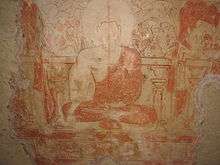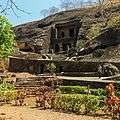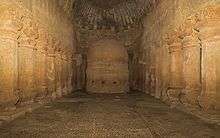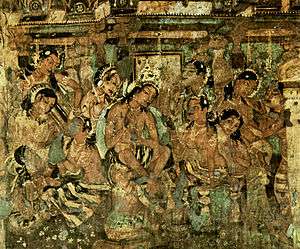Kanheri Caves
| Kanheri Caves | |
|---|---|
| कान्हेरी लेणी (Marathi) | |
|
Prayer hall and Stupa in cave 03 | |
| Location | Sanjay Gandhi National Park |
| Coordinates | 19°12′30″N 72°54′23″E / 19.20833°N 72.90639°ECoordinates: 19°12′30″N 72°54′23″E / 19.20833°N 72.90639°E |
| Geology | Basalt |
| Entrances | 109 |
The Kanheri Caves (Sanskrit: कान्हेरीगुहाः Kānherī-guhāḥ) constitute a group of rock-cut monuments that are located to the southeast of Borivali on the western outskirts of Mumbai, the capital city of Indian State of Maharashtra. Located within the forests of the Sanjay Gandhi National Park, the caves are 6 km from the main gate and 7 km from Borivali Station. Tourists can enter after 9:00 a.m. The Kanheri Caves demonstrate the Buddhist influence on the art and culture of India. Kanheri comes from the Sanskrit Krishnagiri, which means black mountain.[1] They were chiseled out of a massive basaltic rock outcropping.[2]
Description

These caves date from the first century BCE to the 10th century CE. One hundred and nine caves have been carved from the basalt. Unlike the elegant splendor of the adjacent Elephanta Caves, the earlier cells are spartan and unadorned. Each cave has a stone plinth for a bed. A congregation hall with huge stone pillars contains the stupa, a Buddhist shrine. Farther up the hill are canals and cisterns, the remains of an ancient system that channeled rainwater into huge tanks.[3] Once the caves were converted to permanent monasteries, the rock was carved with intricate reliefs of Buddha and the Bodhisattvas. Kanheri had become an important Buddhist settlement on the Konkan coast by the 3rd century CE.[4]

Most of the caves are used as the Buddhist viharas, meant for living, studying, and meditating. The larger caves were chaityas, or halls for congregational worship; are lined with intricately carved Buddhist sculptures, reliefs and pillars; and contain rock-cut stupas for congregational worship. The Avalokiteshwara is the most distinctive figure. The large number of viharas demonstrates the well organized establishment of Buddhist monks. This establishment was also connected with many trade centers, such as the ports of Sopara, Kalyan, Nasik, Paithan and Ujjain. Kanheri was a University center by the time the area was under the rule of the Maurayan and Kushan empires.[1] In the late 10th century, the Buddhist teacher Atisha (980–1054) came to the Krishnagiri Vihara to study Buddhist meditation under Rahulagupta.[5]
Inscriptions at Kanheri
Nearly 51 legible inscriptions and 26 epigraphs are found at Kanheri, which include the inscriptions in Brahmi, Devanagari and 3 Pahlavi[6] epigraphs found in Cave 90.[1][7] One of the significant inscriptions mentions about the marriage of Satavahana ruler Vashishtiputra Satakarni with the daughter of Rudradaman I.[8]
A 494-495 CE inscription found at Kanheri mentions the Traikutaka dynasty.[9]
Paintings in the caves
Cave number 34 has unfinished paintings of Buddha on the ceiling of the cave.

| Pilgrimage to |
| Buddha's Holy Sites |
|---|
 |
| The Four Main Sites |
| Four Additional Sites |
| Other Sites |
| Later Sites |
Location
The caves are located deep inside Sanjay Gandhi National Park. Bus transport is available every hour. Visitors must pay entry fees at the park gate and at the cave entrance.
Around the caves
Kanheri caves offer picnickers a getaway, especially during the rainy season. The hilly terrain of the caves creates several large and small waterfalls. The road from the entry point of Sanjay Gandhi National Park to Kanheri caves is bisected by streams where families can enjoy lazy weekend gatherings.
 The caves as viewed from the base of the hill
The caves as viewed from the base of the hill Rock cut stair leading to Kanheri
Rock cut stair leading to Kanheri Main entrance to the caves
Main entrance to the caves Cave 1
Cave 1 Cave 3
Cave 3 Spartan plinth beds
Spartan plinth beds Vihara - prayer hall
Vihara - prayer hall A vihara
A vihara Kanheri Caves served as a center of Buddhism in Western India during ancient times
Kanheri Caves served as a center of Buddhism in Western India during ancient times Sculpture of Buddha in a temple at Kanheri Caves
Sculpture of Buddha in a temple at Kanheri Caves Cave sculpture of Buddha
Cave sculpture of Buddha
References
- 1 2 3 "Kanheri Caves". Retrieved 2007-01-28.
- ↑ Rajen Noir (2006-10-31). "Mumbai's Ancient Kanheri Caves". Retrieved 2007-01-31.
- ↑ "Mumbai attractions". Archived from the original on 2007-11-09. Retrieved 2007-01-28.
- ↑ "Kanheri Caves Mumbai". Retrieved 2007-01-31.
- ↑ Ray, Niharranjan (1993). Bangalir Itihas: Adiparba in Bengali, Calcutta: Dey's Publishing, ISBN 81-7079-270-3, p. 595.
- ↑ West, E.W. (1880). "The Pahlavi Inscriptions at Kaṇheri". The Indian Antiquary. 9: 265–268.
- ↑ Ray, H.P. (2006). Inscribed Pots, Emerging Identities in P. Olivelle ed. Between the Empires: Society in India 300 BCE to 400 CE, New York: Oxford University Press, ISBN 0-19-568935-6, p.127
- ↑ "A Note on Inscriptions in Bombay". Maharashtra State Gazetteers-Greater Bombay District. Government of Maharashtra. 1986. Retrieved 2012-11-23.
- ↑ Geri Hockfield Malandra (1993). Unfolding A Mandala: The Buddhist Cave Temples at Ellora. SUNY Press. pp. 5–6. ISBN 9780791413555.
Further reading
| Wikimedia Commons has media related to Kanheri Caves. |
- Nagaraju, S. (1981). Buddhist Architecture of Western India, Delhi: Agam Kala Prakashan.



